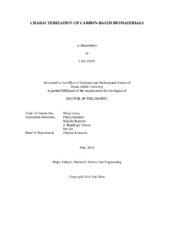| dc.contributor.advisor | Liang, Hong | |
| dc.creator | Zhou, Yan | |
| dc.date.accessioned | 2015-01-09T20:27:12Z | |
| dc.date.available | 2016-05-01T05:30:54Z | |
| dc.date.created | 2014-05 | |
| dc.date.issued | 2014-04-24 | |
| dc.date.submitted | May 2014 | |
| dc.identifier.uri | https://hdl.handle.net/1969.1/152665 | |
| dc.description.abstract | This research evaluates carbon-based biomaterials and investigates their
fundamental mechanisms in bio-lubrication. Approaches include experimental
investigation combined with molecular dynamics simulation. There are four major areas
of investigation undertaken as summarized below.
The gastropod mucus is a natural biological fluid that acts both as a glue and a
lubricant. The chemical compositions, rheological performance, and tribological behavior
of the mucus were explored under various conditions. It was found that the water content
determined the uniqueness of this nature’s lubricant. The results of molecular dynamics
(MD) simulation confirmed the hydration lubrication mechanisms.
The polycrystalline diamond produced by plasma-enhanced chemical-vapor-deposited
(PCVD) was evaluated for the applications in artificial joints. Results
suggested that the diamond material was highly wear resistant and was equally excellent
in biocompatibility as commonly used Ti6Al4V. The protein molecules were found to
bind to the surface of diamond less specifically than it on metal oxide surface.
The effects of molecular structures on lubrication were studied. Carbon-based
additives in water showed the reduction in friction in self-lubricating polymer. The
adsorption of lubricant molecules were correlated to the frictional behavior observed. It
was found that the 2D coverage of atomic level asperities took an important role in
reducing friction. Furthermore, the graphene oxide showed promising anti-infection
capability that is an added benefit for in vivo applications.
Finally, the interactions between proteins and carbon-based biomaterials were studied computationally. The kinetic balance and potential were analyzed. An empirical mathematical model was developed in order to predict the interfacial interactions between protein and the surfaces of biomaterials.
This research bridges the gap between the effects of the structure of the lubricants and the behavior of the same. It provides the basis to design new lubricants that will be more efficient, more environmental friendly, and more durable. The carbon-based biomaterials would lead to a new generation of artificial joints that help to improve the quality life for patients who need prosthesis. | en |
| dc.format.mimetype | application/pdf | |
| dc.language.iso | en | |
| dc.subject | biomaterials | en |
| dc.title | Characterization of Carbon-Based Biomaterials | en |
| dc.type | Thesis | en |
| thesis.degree.department | Materials Science and Engineering | en |
| thesis.degree.discipline | Materials Science and Engineering | en |
| thesis.degree.grantor | Texas A & M University | en |
| thesis.degree.name | Doctor of Philosophy | en |
| thesis.degree.level | Doctoral | en |
| dc.contributor.committeeMember | Hemmer, Philip | |
| dc.contributor.committeeMember | Radovic, Miladin | |
| dc.contributor.committeeMember | Vinson, S Bradleigh | |
| dc.contributor.committeeMember | Qu, Jun | |
| dc.type.material | text | en |
| dc.date.updated | 2015-01-09T20:27:12Z | |
| local.embargo.terms | 2016-05-01 | |
| local.etdauthor.orcid | 0000-0001-7973-2316 | |


